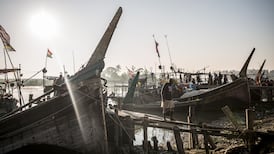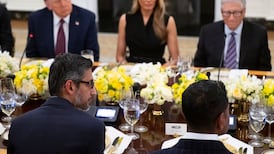US president Donald Trump awarded himself a long victory lap as he announced the success of last weekend’s operation against Abu Bakr al-Baghdadi, the Isis leader, gloating over the supposed details of his demise.
It is a significant success for US special forces to have killed the leader of the most savagely ambitious jihadis of this century. This raid is probably more important than the killing, under President Barack Obama in 2011, of Osama bin Laden, author of the 9/11 attacks on US soil a decade earlier, who had by then faded into an afterlife of myth as his al-Qaeda movement of Islamist insurgents faltered.
Despite that, Mr Trump’s irresponsible policies in Syria and the Middle East could still help Isis rise from the ashes.
That the Baghdadi operation happened in Syria takes some of the heat off Mr Trump so soon after he was roasted by bipartisan critics in the US Congress for withdrawing American troops from the north-east of the country; abandoning Syrian Kurd allies, who had fought alongside the US-led coalition against Isis for five years; and creating conditions for the jihadis to regroup along the Euphrates river valley.
Baghdadi was found hiding in Idlib in north-west Syria rather than, as was widely supposed, along the Syria-Iraq border. Idlib is the last rebel redoubt in Syria, but the dominant faction is Hayat Tahrir al-Sham, the former al-Qaeda group that split violently with Baghdadi’s Isis and hunts its adherents. The north-west border province is also under the watchful eye of Turkey, which maintains 12 troop positions and an intelligence presence there.
This is feeding speculation that Recep Tayyip Erdogan, Turkey’s president, may have offered an actionable lead on Baghdadi to Mr Trump in their October 6 telephone conversation, after which Mr Trump announced the US withdrawal from Syria. While that remains to be seen, the pullback and its collateral effects could yet prove disastrous.
Isis may have lost the territory of its Baghdadi-anointed caliphate in eastern Syria and western Iraq. But it is still operational. It is worth recalling how a similar triumph against jihadis in Iraq a decade ago unfolded.
The precursor of Isis was the al-Qaeda franchise led by Abu Musab al-Zarqawi, who turned Iraq into a charnel house after the US-led invasion of 2003. This group morphed into Islamic State of Iraq. After Zarqawi’s death in a US air strike in 2006 (hailed, at the time, as a triumph by President George W Bush), the proto-caliphate of jihadi cut-throats over-reached.
A revolt by the Sunni tribes of western and northern Iraq triggered the US troop “surge” that in 2007-09 almost obliterated ISI, reducing it to about 600 fighters. Yet, as David Kilcullen, a counter-insurgency adviser to General David Petraeus, the surge commander, puts it, the survivors “regrouped alongside former Saddam [Hussein]loyalists, intelligence and special operations people, specialists in clandestine warfare, who tended to hang back, direct traffic and treat the jihadis as useful idiots to further their own goals”.
It was in a US prison in Iraq that Baghdadi linked up with these Sunni supremacists. Isis was born. Only five years after its near-death experience in Iraq, the second incarnation of Islamic State came close to capturing Iraq and Syria, whose armies disintegrated before them. They were finally pushed back by Iran-backed Shia militias and US-backed Kurdish fighters.
Yet, in early 2014, as Isis poured back into west Iraq from the chaos in Syria that re-incubated it, Mr Obama, with hubristic swagger, described the people who would bring terror and destruction to great swaths of the Levant as the “JV”, or junior varsity team, of terror.
So what is the position after Baghdadi? First, Isis reportedly already has a new leader in place. It does not need black-shirted actuaries to forecast the limited lifespans of its leaders. It has a bench of cadres in waiting.
Second, it is still heavily present in and around Syria and Iraq. The Turkish invasion of north-east Syria, in the vacuum left by US troops, has forced Kurdish militia to defend themselves rather than guard camps holding up to 12,000 Isis prisoners. This, in turn, has led to jailbreaks. Isis is still well-implanted in ungoverned spaces, especially in south and central Asia and across Africa.
Third, in Syria and Iraq alone, most serious estimates reckon Isis has up to 40 times the number of fighters its predecessor was left with - surely enough to resurrect a third time. These fanatics, including thousands of European volunteers, have gone to ground in two rotting states.
Fourth, the sense of Sunni Arab grievance in the former caliphate looks structurally ingrained. Iran-backed Shia militia hold the whip hand in Iraq. President Bashar-al Assad’s minority regime in Syria, backed by Iran and Russia, is regaining control over most of the country. Millions of Sunni refugees in neighbouring countries see little hope of return.
Mr Bush’s invasion of Iraq inadvertently created a sectarian Shia order there and Mr Obama’s failure to back a Sunni rebellion in Syria reinforced it - nurturing the radical despair Sunni jihadis feed on.
David Gardner is International Affairs Editor at the Financial Times
FT Service








